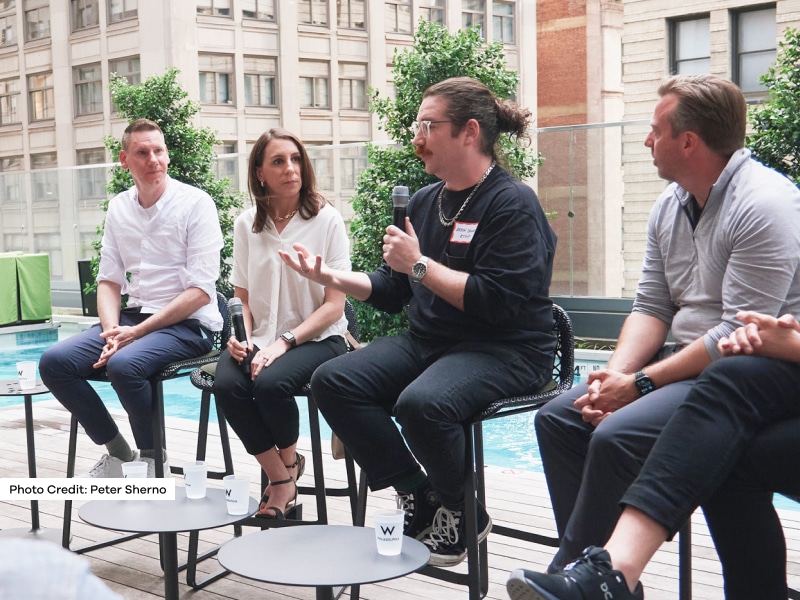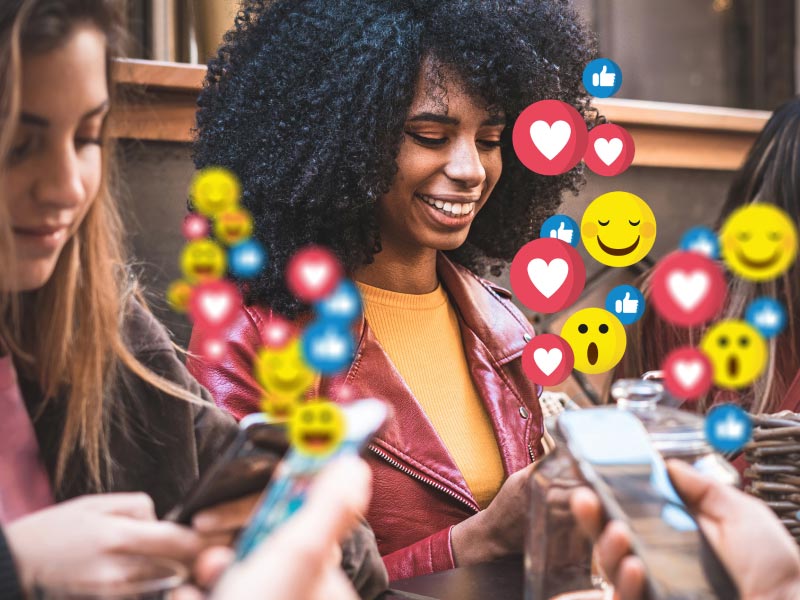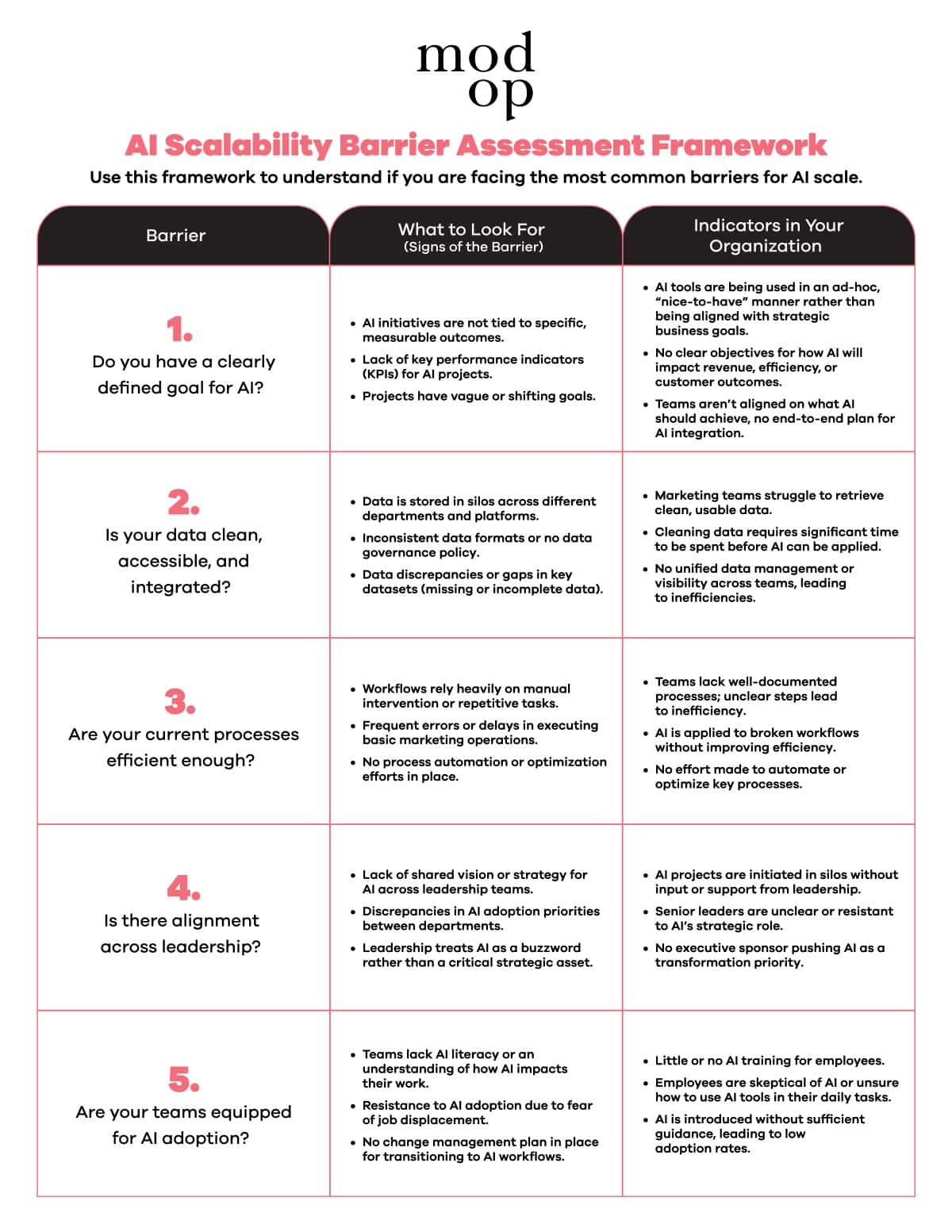The rapid evolution of artificial intelligence is transforming industries, reshaping workflows, and redefining leadership. While AI promises innovation and efficiency, it also brings challenges that require ethical, inclusive, and purpose-driven leadership to navigate.
Women leaders are emerging as pivotal to this transformation, driving responsible AI adoption, fostering creativity, and ensuring technology serves a greater purpose. At this critical moment, women have an opportunity—and a responsibility—to step forward and shape AI’s future.
I recently had the incredible opportunity to join the She Leads AI: Leading Change at Critical Moments event as a panelist. The event brought together powerful voices and experiences that showcased the courage, leadership, and perseverance women bring to this unprecedented moment in AI. If you’re a woman looking to blaze your own trail in AI or technology, seeking empowerment, or if you’re anyone looking for the inspiration to take a bold step forward, this event delivered the perfect level of motivation and momentum. Read on for my key takeaways and insights from this incredible event.
Why Women Leaders Matter in AI Transformation
AI is more than a technological shift; it’s a societal transformation on par with the internet or the industrial revolution – even the invention of fire! It requires leaders who are empathetic, strategic, and collaborative—traits women consistently demonstrate in leadership roles.
When panelists were asked, “Why women?”—why women are so essential to this movement and this moment—I shared one of my favorite studies. A 2019 McKinsey report identified five critical leadership traits for future success: inspiration, participative decision-making, setting expectations and rewards, people development, and role modeling. Women were found to demonstrate these traits more consistently than men. These traits are exactly what organizations need to lead transformation today—leadership that prioritizes people first.
Trust Yourself: There Are No Experts—Just Leaders
Generative AI is new to everyone. No one has mastered it all yet, and this fact is freeing. At this moment, there’s no space for “imposter syndrome”—something that women experience more often than men (Psychology Today). AI is evolving too quickly, and the stakes are too high.
We cannot let this moment pass without stepping up. This is a unique moment where everyone is learning, and there’s no time to hold back due to imposter syndrome. AI’s impact is being defined in real time, and your leadership, perspective, and voice are essential to ensuring it is shaped for the better.
Jennifer Ives, Vice President of Artificial Intelligence & Modernizing Government at the Partnership for Public Service, perfectly captured the urgency:
“Women are falling behind in the world of AI, five to nine times faster than men are adopting it. This cannot happen.” “Everything is up for grabs at the moment. Do not assume someone else knows more than you. Have a voice. Do not say, ‘That’s for someone else.’”
Stories That Inspire: Women Leading Change
At the event, I had the privilege of hearing stories from women leaders who are transforming workflows and leading teams through AI-driven change. Their advice was simple but powerful:
- Start small: Identify a single process where AI can make an impact. Ann McCrackin, Founder of AI-Enabled Attorney LLC and Adjunct Law Professor at UNH Franklin Pierce Law Center, reminded us: “Don’t forget about the simple day-to-day tasks and the way AI tools can help you. It doesn’t have to be about the big, flashy AI tools—start where you are and build from there.”
- Build momentum with small wins: Use early successes to build momentum. Paige Lord, Founder & CEO of Just AI Media, reinforced this: “Great technological and human breakthroughs often begin with really small, courageous, seemingly insignificant acts of imagination.”
- Support others along the way: Empower your peers to step into leadership roles. Reflecting on my own experience, I shared that my own spark was supported and encouraged by many other women in the space. That encouraged set me off on my path and ignited everything for me.
The power of mentorship and collaboration is transformative. When we lift each other up, we lift the entire team and organization.
Why Now Is the Moment
AI’s role in business and society is being defined right now. The transformation is happening now. Women have a unique opportunity to guide its trajectory and ensure it solves problems rather than perpetuates them.
As Melissa Brown, People Strategist and Thought Leader at Holland & Hart LLC, said:
- “We are not witnessing change; we have the opportunity to be a part of it.”
- Louisa Fernanda Molano, founder of HERlocity, captured this sense of urgency:
- “It is not an accident that you were born for this moment in time. You were made for this.”
The organizations that thrive in this new era will embrace purpose-driven leadership that prioritizes inclusion, ethics, and creativity.
Leading the Way Forward
How we choose to lead in this moment will determine whether it benefits our businesses, teams, and society as a whole. The insights and inspiration shared at She Leads AI reinforced a simple truth: leadership isn’t about having all the answers—it’s about showing up, learning, and moving forward with purpose and courage.
At Mod Op, we have a tremendous opportunity to help our clients navigate this AI era with confidence, creativity, and responsibility. Whether you’re driving campaigns, building strategies, or solving challenges for your teams, your voice, your ideas, and your leadership matter—and they are needed now more than ever.
AI may be redefining the future, but it’s leaders like you who will determine what that future looks like. Let’s lead the way forward together.
If you’re ready to take action, join the conversation, and explore how AI can deliver results for your clients and teams, Mod Op is here to support you every step of the way. Together, we can make this transformative moment one that drives impact, innovation, and opportunity for all.
The Latest
We study the game as hard as we play it.
Learn with us what’s now and next.
Related Stories
ChatGPT, the language model developed by OpenAI, has quickly become a familiar tool for many marketers. By now, you and your team have likely either experimented with ChatGPT or another popular large language model (LLM) like Google’s Gemini, Bing AI, Anthropic, Jasper AI or Microsoft CoPilot (which helped me draft this blog post).
LLMs like ChatGPT are transforming the way teams approach content creation, customer interaction, and data analysis. This technology has even seeped into the marketing creative process.
In this blog series, we’re looking at the synergy between AI and human creativity, focusing on how tools like ChatGPT can fuel and enhance creative processes rather than replace them. It’s a series made possible by Mod Op’s AI Playground — an initiative designed to fast-track innovation by allowing team members to experiment with new AI tools quickly and responsibly. If someone finds a promising app, they can submit it. If the application passes our rigorous AI risk and compliance framework, the IT team will assist in setting up a 90-day evaluation period, during which users provide insights on the app’s value. This process aims to enhance skills, extract value faster, and identify any limitations of the tools.
As you might imagine, ChatGPT, which is used across teams and marketing disciplines at Mod Op, was one of the first apps to hit our AI Playground.
16 Applications of ChatGPT in Marketing
With over 400 specialists and marketing services ranging from brand positioning and advertising to data analysis and domestication, our team touches nearly every facet of marketing. We’re perfectly positioned to test how this multifaceted tool can be applied to all different types of marketing services and specializations.
Just getting started with AI? Here are 16 easy ways that marketers can use ChatGPT:
- Email subject line and preheader
Use ChatGPT to craft compelling email subject lines and preheaders that capture attention and drive open rates.
- Ideation and email copy rough drafts
Use ChatGPT to brainstorm fresh ideas and draft preliminary email copies that capture your target audience’s attention.
- Social ad/post copy ideation and rough drafts
Leverage ChatGPT to brainstorm and create initial drafts for social media ads and posts, ensuring your copy is engaging and tailored to your audience.
- Meta description drafts
Use ChatGPT to analyze your content and generate concise, keyword-rich meta descriptions, but be mindful of SEO best practices. As Mod Op’s SEO Director Garreth Cunningham cautions, “I wouldn’t recommend using ChatGPT to do meta descriptions in a vacuum. Things I would keep in mind when using GPT, are things like the keyword strategy/data, cannibalization and any new/updated information architecture requirements.”
- Drafting image alt text
Drafting image alt text is crucial for both accessibility and SEO, as it ensures that content is accessible to all users, including those with visual impairments, and helps search engines understand the context of images. ChatGPT can be used to craft clear, descriptive, and concise alt text that accurately represents the image content, enhancing the overall user experience and improving search engine rankings.
- Concept ideation for digital campaigns
ChatGPT can be used to brainstorm and develop concepts for digital campaigns. You can provide ChatGPT with information about your target audience, campaign goals, and brand messaging. The model can then generate a variety of campaign ideas, including potential themes, slogans, and visual concepts
- Research summarizing
With human oversight, ChatGPT can analyze lengthy research reports, articles, and market data to provide concise summaries of key findings and insights.
- Extracting the best quotes from audio/video transcripts
Consider using ChatGPT parse audio or video transcripts to extract the best quotes for use in written marketing materials. “I use ChatGPT to extract the best quotes from transcripts of Mod Op’s Leader Generation podcast,” shares Mod Op Director of Copywriting Cheryl Boehm, “It saves me time from reading through transcripts myself or re-listening to 30 minutes of audio.”
- Writing YouTube Title/Description from a transcript
Just as ChatGPT can extract quotes from audio or video transcripts, it can also be used to develop optimized titles and written descriptions. By sharing your keyword research with the LLM, you can further enhance its ability to generate titles and descriptions that are tailored to YouTube’s algorithm.
- Code development and optimization
As Mod Op VP of Digital Experience and Technology Fabio Fiss shares, our team “frequently uses ChatGPT for coding tasks, including writing scripts, optimizing code snippets, and rewriting statements to make them more efficient. It’s often utilized for generating quick solutions or guidelines, such as PHP database calls or JavaScript functions.”
- Debugging and troubleshooting
“ChatGPT is valuable for troubleshooting, especially when developers need to understand errors or generate explanations for unexpected behaviors.” shared Fabio. “It serves as a first line of inquiry to identify potential causes or offer starting points for debugging.” This is also a top use case for those executing paid channel marketing. “ChatGPT has been a helpful resource for our team in navigating platforms like GA4 and Google Tag Manager,” says Hannah Woodham, VP Paid Channel Marketing at Mod Op. “Whether it’s debugging tracking issues or troubleshooting complex configurations, it serves as a responsive and reliable resource, helping us resolve challenges quickly and stay focused on driving results for our clients.” - Data generation and testing
“ChatGPT simplifies the creation of test data by generating dummy datasets and mock responses” shared Fabio, “This feature helps streamline the testing process, allowing the team to quickly simulate various scenarios.” He goes on to share that “Developers also find it useful for generating structured data in different formats (e.g., JSON, XML), which can be used in unit tests or integration tests. This capability significantly reduces the time spent manually creating test cases.”
- Guides and documentation
Marketers, including those working in areas like digital experience (DX) or product marketing, can leverage ChatGPT to create comprehensive guides and documentation, streamlining the process and enhancing user support.
- Coding and search ideation
ChatGPT can be a valuable resource for both coding and search ideation. It can generate code snippets and explain code concepts. Additionally, ChatGPT can assist with brainstorming search topics, finding relevant keywords, and refining search queries. “Ideation is an application of ChatGPT I hear frequently across our agency,” shared Patty Parobek, VP of AI and Machine Learning Transformation Change at Mod Op. “For example, as we’re digging into niche industries, we can use ChatGPT to help us explain terms in simple ways and ideate search keywords from a searcher standpoint. That’s helpful for our SEO and paid search teams, as well as others who are working on projects digital experience or user experience.”
- Press release ideation and rough drafts
“ChatGPT is effective for press release ideation and drafting due to its speed and ability to generate structured content based on specified prompts and some background details,” said VP PR Sasha Dookhoo, “It can provide foundational drafts, suggest headlines, and explore different story angles.”
- Tailoring media pitches to journalists and media outlets
With a media pitch and a little bit of information about the journalist or outlet they’re looking to target, PR professionals can use ChatGPT to tailor pitches to better resonate with their intended recipient.
A word about AI Responsible Use: According to ISACA, only about 10% of organizations have formal policies in place specifically for generative AI. At Mod Op, we’re committed to earning and keeping our clients’ trust by leading the way in responsible AI use. As part of our AI Playground and formal AI application evaluations, we assess risk levels based on four key categories — data protection and privacy, security and compliance, legal and ownership, and ethical considerations — to inform application responsible use and controls. Only tools that can meet our rigorous risk framework threshold make it into our AI Playground, and of these tools only those with explicit client consent can be utilized for proprietary client data or in client deliverables.
Want to learn more about Mod Op’s work in AI? Visit The AI Edge to explore our AI-powered solutions and how we’re helping our clients navigate their own AI adoption journeys.
The Latest
We study the game as hard as we play it.
Learn with us what’s now and next.
Related Stories
The new year is a natural time for reflection — which campaigns moved the needle, how did marketing trends turn plans on their head, and where did KPIs shift? 2025 offers a fresh perspective and a chance to consider and prepare for what lies ahead.
We asked leaders across Mod Op to share their predictions for what’s to come in 2025. They offered thoughts on the unexpected impact of AI, the Ripple effects on media and culture, and everything in between.
Here are the most significant marketing trends we believe will drive business in the coming year.
Demand for ROI on AI will Drive Data Quality Improvements and Raise the Bar for Talent
AI startups and powerful AI apps are booming. But without quality data and targeted upskilling, businesses that plan to use AI to drive growth will fall short. As CEOs and boards demand measurable ROI on AI, two issues—data quality and the right talent —will become critical. Short-sighted companies may cut staff to lower costs, relying on AI in isolated roles, but this approach leads to stagnation. Productivity gains alone don’t equal customer value.
In contrast, forward-looking companies will invest in department-specific training and data strategies to scale AI’s impact across the organization. They recognize that ad hoc AI use is not a growth strategy. To achieve lasting gains, these companies are building continuous testing and feedback loops to identify where and how they can leverage AI to deliver incredible customer value that reflects their brand, their vision and their commitment to those they serve.
Tessa Burg
CTO
We’ll Push the Limits of AI (While Keeping the Value of Human Creativity)
And so, it’s begun… the era of clients saying, “Can you just have AI do that?” And it’s often about things that AI can’t do. Next year will be a huge one for clients (and agencies) learning about the limits of AI and exactly how much human input is still needed, despite the advances made. Of course, since it’s AI, everything will change by the end of next year. But, hey, if you don’t love and embrace permanent change, you’re probably in the wrong business.
Steve O’Connell
Co-Chief Creative Officer
Flexible LED Screens Technology, Virtual Environments, AI and AR/VR Will Drive Changes in Experiential Content
As we approach 2025, I’m seeing dramatic trends in the experiential content space. The most exciting ones include the emergence of flexible LED screen technologies, the rise of virtual environments, AI powered content production, and immersive/responsive, multi-sensory experiences using AR/VR and AI-powered XR. All these technologies will personalize consumer engagement and get a piece of marketing department spend.
Flexible LED screen technology allows creatives to bend screens and content to their will. The Sphere in Las Vegas and immersive art exhibits are just the start. AI powered creative tools will help content creators lean into programmatic generative content production that once was the exclusive proprietary solution of artists like Refik Anadol.
In 2025 we will see more multi-sensory virtual tour experiences that allow users to interact with museum exhibits, historical figures or the artwork itself. We will see more data integrated into live content production and events. This will allow the immersive experiences to adapt in real-time, creating personalized experiences for the customer.
As the digital and physical worlds blend, we see more brands incorporating AR/VR and AI to engage and personalize experiences. Examples include AR/VR in retail where customers are virtually trying on clothing. Or AI powered personal trainers helping consumers stay fit. We will also expand the use of augmented reality in sporting events where the live AR overlays will become commonplace.
2025 will be a year where we get more comfortable with the new AI tools creatives have at their disposal. Experiences that are real-time responsive are going to be the norm. And consumers will expect AI tools to help them stay fit, see art in a new way and experience the power of technology.
Mark Bennett
EVP, Creative Studio
Brand World Will Become More Prominent
The idea of a ‘brand world‘ will become more prominent, where all aspects of a brand’s visual and experiential elements are unified. This includes packaging, advertising, digital experiences, and in-store displays, creating a cohesive and immersive brand experience.
Philip Congello
EVP, Client Success
We’ll See a Renewed Demand for Human Oversight and Authenticity
This is a big one for me: I think in 2025, maybe late 2025, there will be a big pendulum swing back to ensuring human in the loop and human authenticity. I think over-reliance on GenAI in companies with broad access to ChatGPT, etc, will lead to mistakes and ethical concerns, and that will spark a renewed focus on human oversight, authenticity, and human in the loop/QA in marketing. At the same time, we’ll be craving human experiences with all the AI noise. AND as automation and AI streamline many marketing tasks, PR, branding, and human experiential marketing will become critical investment channels for visibility and connection.
Patty Parobek
VP, AI Transformation
Authenticity Will Help Savvy Marketers Cut Through the Noise
If content is king, authenticity wears the crown!
Generating content has become much easier in the past decade, with the latest AI tools taking things to the next level. While this has opened doors for many brands, the negative side effect is content oversaturation and, at times, mediocrity. To fight through the noise, authenticity will be key: know your voice and own it, in every channel, if you want to make an impact with your target audience.
Christina Phillips
VP, Account Director
We’ll See an Emphasis on Small Data
Small data is poised to shine in 2025. We’ll see proof that quality over quantity matters for market research data sets, for several reasons:
Small data is agile – the ability to quickly collect and process small data sets means that results are available sooner, leading to faster outcomes and decisions. This nimbleness is critical in today’s accelerated business environment where companies need to rapidly adapt to changing market conditions. Businesses that embrace data-driven decision-making are 5x more likely to make faster decisions, giving them a competitive edge.
Small data leads to actionable insights. By focusing on specific customer preferences and behaviors, small data enables businesses to make informed decisions based on precise, relevant information rather than broad generalizations. In fact, 38% of customer experience leaders want to improve the actionability of customer feedback and metrics.
Small data is cost-effective – small data sets require fewer resources, whether considering the cost to collect the data or analyst hours to make sense of it. Budget is almost always a factor, so why not consider an efficient option when appropriate?
The growing recognition that large data sets don’t always lead to better insights is driving the current shift towards small data. Sometimes, more respondents can magnify inherent biases rather than adding clarity. Small data’s focused approach can provide relevant and accurate insights. In 2025, remember that small and mighty can often save the day.
Lauren Schmidt
Senior Director of Market Research and Strategy
As for me, I believe the prevalence of niche communities means that marketers will no longer be able to bank on mega campaigns or singular tentpole marketing events. 360 campaigns will become more essential, and in some cases, marketers will have to prioritize which customers to target, when and where, excluding secondary or low-value customers from their targeting.
The trend of media fragmentation is nothing new; we’ve seen it time and again — with cable TV in the ‘80s and ‘90s and again with the rise of social media platforms like Facebook, Twitter, and YouTube in the early 2000s — and I feel we may be at another inflection point. As AXIOS co-founders Mike Allen and Jim VandeHei put it this fall, the big media era is over. We need to be prepared for what that means as marketers.
What marketing trends do you expect to see dominate 2025? Connect with Mod Op on LinkedIn to share your thoughts.
The Latest
We study the game as hard as we play it.
Learn with us what’s now and next.
Related Stories
In my previous post, “Becoming Digital: Technology Comes Last,” I talked about a common misconception: companies often believe that digital transformation is all about technology. Yet technology should be the last thing on your mind when you begin planning a digital transformation. To be successful, digital transformation needs to start with a deep understanding of your customers and their met and unmet needs.
The Outside-In Approach
At Mod Op Strategic Consulting, we call this an “outside-in approach.” The point is that digital transformation isn’t just about implementing new technologies—it’s a mindset shift that places the customer at the center of everything you do.
Instead of focusing on internal processes and technologies, an outside-in approach starts by understanding your customer’s journey, pain points, and expectations. This allows you to identify the true value drivers for your business and make strategic investments that will deliver real results for your customers and your bottom line.
Why is the Outside-In Approach So Powerful?
In today’s digital landscape, customer expectations have changed dramatically. Customers are accustomed to seamless, personalized experiences, and they expect the companies they do business with to provide the same level of service they receive from companies that they work with in their personal lives, like Amazon and Uber.
Failing to adapt to these expectations can have serious consequences, leading to customer churn, decreased revenue, and ultimately, obsolescence in the market.
An outside-in approach helps you avoid these pitfalls by:
- Ensuring that your digital strategy is aligned with customer needs.
- Identifying opportunities to improve the customer experience.
- Prioritizing investments in areas that will deliver the greatest value to your customers.
How to Implement an Outside-In Approach
The first step is to gather direct feedback from your customers. This can be done through interviews, surveys, focus groups, and other methods.
The key is to ask the right questions:
- What are your biggest challenges when doing business with us?
- What are your expectations for a digital experience?
- What features or services would make your life easier?
The insights gained from this feedback will be invaluable in shaping a digital transformation strategy. They will help:
- Identify the areas where you need to improve
- Develop new products and services that meet your customers’ needs
- Make informed decisions about technology investments
Remember, digital transformation is a journey, not a destination. By adopting an outside-in approach and continuously seeking feedback from customers, you can ensure that your business remains relevant, competitive, and customer-centric in the ever-evolving digital landscape.
To learn more about how to implement an outside-in approach in your organization, check out our book, “Getting Digital Done: An Executive Guide to Growth and Transformation”.
The Latest
We study the game as hard as we play it.
Learn with us what’s now and next.
Related Stories
In early November, I had the opportunity to attend two pivotal automotive industry shows: SEMA and AAPEX in Las Vegas. These events are essential for anyone involved in the automotive sector because they offer a comprehensive look at both the OEM and aftermarket landscapes. SEMA, known for its vibrant display of innovative and futuristic cars, attracts a diverse crowd, including consumers and industry professionals. In contrast, AAPEX focuses more on the automotive aftermarket, providing a strategic environment for industry-specific discussions and networking.
Over the years, I’ve seen significant growth in both shows, reflecting the steady expansion of the automotive industry, even through challenging times like the COVID-19 pandemic.
This year, the discussions highlighted the industry’s resilience and adaptability, as well as the critical importance of lead generation and efficiency in marketing strategies. Join me as I delve into the insights and trends from these influential events.
Key topics at SEMA and AAPEX 2024: Tariffs, Insurance, and EVs
Here are some of the key discussions and trends that emerged from SEMA and AAPEX 2024:
Tariffs and their impact on the industry: Uncertainty around tariffs, which could range from 10% to 60%, generated a lot of conversation. For example, I talked to a chemical company that said if tariffs go up to 60%, they’ll have a windfall. But on the other hand, some manufacturers are worried that car prices could increase by 30% if they have to manufacture everything in the US. This was a big topic, especially since I happened to be there on Election Day, making it top of mind for many people.
Insurance costs: Insurance was an important topic at the show because increases in automotive insurance costs, among other economic factors, impacts car purchase consideration, something that affects both OEMs and aftermarket.
Electric Vehicles (EVs) and emerging technologies: During the show, electric vehicles (EVs) and emerging technologies were prominent topics. Companies are investing heavily in EV technology, with significant advancements in vehicle range, now reaching up to 400 miles on a single charge. However, infrastructure challenges, particularly in rural areas, remain a concern. Hydrogen fuel technology also garnered attention, though its widespread adoption is still uncertain. Additionally, manufacturers are focusing on improving efficiency through advancements in transmissions, lubricants, and other components.
Sustainability: Sustainability was a visible trend at the show, with many exhibitors highlighting their efforts in this area. However, when discussing sustainability in detail, it became clear that while companies are incorporating sustainable practices, it often serves more as a checkbox rather than a primary focus.
What OEM and other marketers in the automotive industry are talking about
In addition to exploring industry trends, I spoke with many marketers during both shows. My conversations reflected a broad desire to produce tangible business outcomes. Here’s what OEM and other marketers in the automotive space are expecting and focusing on as we move into 2025:
Lead Generation: Lead generation is still a critical focus for automotive industry marketers. They are particularly interested in tools and strategies that can help generate more leads and close more clients. This includes leveraging AI and other technologies to improve efficiency and achieve better ROI. Marketers are moving away from traditional metrics like awareness and impressions, focusing instead on business goals and sales targets.
Efficiency in Marketing: Efficiency in marketing is a key concern. Marketers are looking for ways to streamline their processes and make their efforts more effective. This includes the use of AI tools to automate tasks and improve productivity. Additionally, there is a focus on better integration of marketing systems to ensure data flows smoothly and supports decision-making.
Data Utilization: Many companies are either struggling with too much data they don’t know how to use, or they’re lacking sufficient data to make informed decisions. This problem is prevalent both in marketing and operational contexts. For example, I spoke with one company whose marketing systems are not communicating effectively, which hampers their ability to use data for better outcomes.
Conclusion
My main takeaway from last week? SEMA and AAPEX continue to be valuable shows for anyone aiming to make a mark in the automotive industry. These events not only highlight the latest innovations and trends, but also provide a vital platform for networking and strategic discussions. As we look ahead to 2025, the emphasis on lead generation, marketing efficiency, and data utilization will likely shape the strategies of OEMs and other marketers in the automotive sector. I look forward to seeing where 2025 takes the industry.
The Latest
We study the game as hard as we play it.
Learn with us what’s now and next.
We’re experiencing a QR code renaissance. Invented in 1994, the QR tech that some thought to have peaked in the mid-2000s, is today gaining in popularity and is found across more and more media – there’s even a movement underway to have QR codes replace the ubiquitous bar code!
This resurgence is being driven by today’s pivotal shift in how brands engage with consumers. The technological capabilities bundled into every QR code perfectly aligns with the broader trend toward integrating digital technology with physical packaging to create more dynamic, interactive brand experiences.
Today, QR codes have innovative uses in packaging and point-of-sale, and they’ve made a significant impact on consumer engagement, branding and sales.
Innovative Uses of QR Codes
QR codes have transcended their original purpose, becoming gateways to immersive digital experiences that come directly from a brand’s physical packaging. Brands are leveraging QR codes not just for information sharing but as a tool for storytelling and engagement.
For instance, QR codes now link to vineyard tours for wine brands, offering a real-time connection between the product and its origin. This innovative use not only enriches the consumer experience of connecting with a brand, but also adds a layer of transparency and trust between the brand and its customers.
QR codes also allow brands to keep pace with the speed of information and trends. What we’ve seen more recently at retail is the use of QR codes on-shelf or in displays. As a result, brands can instantly change their messaging by updating the digital experience and are no longer limited to the one message printed on the package or on the point-of-sale material at the time.
Impact on Simplified Packaging
The move to simplified packaging has been significantly influenced by the adoption of QR codes. As brands move toward cleaner, more minimalist designs, QR codes offer a way to maintain a library of rich content of information which becomes accessible with a simple scan.
This approach aligns with consumer preferences for less cluttered packaging while still providing access to detailed product stories, nutritional content, product usage, and sustainability. QR codes have become a critical element in balancing aesthetic simplicity with informational depth.
QR Codes and the “Brand World”
QR codes are also integral to the concept of a brand world, where every touchpoint of a brand offers a consistent, immersive experience. By linking physical products to digital experiences, they help extend the brand’s presence beyond the shelf. The result is a cohesive narrative that spans online and offline realms, enhancing the overall brand perception and deepening consumer engagement.
(Expect to hear more on the concept of brand world as we look toward 2025 and beyond!)
2025 and Beyond!
Looking ahead to the future, QR codes are expected to become an even more integral part of a brand’s packaging,
Advances in technology may allow brands to offer more personalized experiences based on user preferences or past interactions, making each scan a unique entry point into the brand’s world. Furthermore, as augmented reality (AR) and virtual reality (VR) technologies mature, QR codes will continue to enhance immersive experiences, transforming the way consumers interact with brands.
What’s more, industry experts continue to discuss the upside opportunity to replace traditional barcodes with QR codes, because QRs provide significantly more information while crossing over into the digital world. The goal is to have a single QR code deliver customer engagement as well as point-of-sale and inventory scan requirements of the industry.
Who would have thought that some 30 years after the launch of the QR code, it would be experiencing a renaissance during the digital shift in packaging and branding strategies. Its ability to connect the physical and digital worlds opens endless possibilities for creative engagement, storytelling, and consumer interaction.

The Latest
We study the game as hard as we play it.
Learn with us what’s now and next.
Related Stories
Coming out of MAICON 2024, one thing is very clear: organizations still cannot scale AI. Multiple sessions covered the top barriers, biggest gaps, and hardest challenges we struggle to solve. This brings us to the second key point – scaling AI is a serious business strategy. (Big shout out to Gary Survis, Ashley Gross, and Jessica Hreha for their MAICON material that inspired this post).
To scale AI effectively, you need to stop treating it like a series of disconnected experiments and instead take a serious, strategic approach. Here’s how to assess and overcome the common barriers to AI scalability like a well-run, mature organization:
Assess Your AI Pilots and Workflow Experiments
Take stock of your current AI pilots and where you’re experimenting with AI. Are these initiatives tied to clear business goals, or are they more “random acts of AI”? Review what’s working and what’s not by examining the outcomes and how they’ve integrated into broader workflows.
Professional Take: Assess each initiative’s ROI and alignment with long-term business objectives. Determine if these AI tools are solving a significant problem or merely offering a short-term, surface-level fix.
Identify the Barriers to Scaling AI
Compare your existing AI initiatives against the common barriers to scale:
- Do you have a clearly defined goal for AI, or is it just “nice to have”?
- Is your data clean, accessible, and integrated across systems?
- Are your current processes efficient enough for AI to be applied effectively?
- Is there alignment across leadership and the organization on the AI strategy?
- Are your teams ready and equipped to adopt AI in their workflows?
Address Each Barrier Like a Mature, Scalable Business
You can’t half-heartedly apply AI solutions if you want to scale. Here’s how to systematically solve these barriers with a serious, grown-up business mindset:
- Set Clear, Measurable Goals: Define exactly what you want AI to achieve for your business. This is foundational. No goals, no scalability.
- Fix Your Data: Conduct a full data audit. Clean, organize, and integrate your data across systems. No more siloed, fragmented data if you expect AI to be effective. If this sounds impossible, our Mod Op Strategic Consulting group will help you.
- Optimize Processes First: Don’t apply AI to broken processes. Streamline and document your workflows, then look for where AI can genuinely augment or automate tasks.
- Align Leadership and Teams: Ensure leadership buy-in and clear communication around AI initiatives. This isn’t just about tools; it’s about transforming how your organization works. Bring teams along early, get their input, and ensure they have the skills they need to adopt AI at scale.
Last: Commit to Iterative Improvements – This Is a Journey
Scaling AI isn’t a one-and-done process. Even after overcoming these barriers, it’s essential to constantly review, refine, and optimize. Approach AI adoption with the same rigor you would apply to any other major business transformation.
In short, treat AI like what it is — a high-priority business initiative: with a clear strategy, the right tools, and the commitment to doing the hard work required for true scalability.
The Latest
We study the game as hard as we play it.
Learn with us what’s now and next.
Related Stories
What does it truly mean to “become digital”? What if I told you that it isn’t about technology? That to plan a digital transformation, technology is the last thing you should think about?
I recently co-authored a book with Mod Op’s Eric J Bertrand and Jonathan Murray that addresses the challenges of digital transformation. The book, “Getting Digital Done,” reveals how companies can effectively make digital, data, and AI transformations to stay competitive in a rapidly changing market.
This post (and others to come) distills some of the learnings from the book – but please check it out, as it offers far more detail and comes with a range of tool kits, checklist, and lessons learned.
Above all, becoming digital is a significant transformation that can be the chief driver of success in the modern business landscape.
Tackling Business Problems
Mod Op Strategic Consulting helps clients with the strategy and execution of digital transformation, but they typically do not come to us and demand, “Make us digital!” Instead, they talk about a business problem: their customers want something that they’re not equipped to provide; they don’t have the data, or it’s not joined up; their infrastructure is running out of capacity; their competition has leapfrogged them; they see opportunities to innovate but they just don’t have the tools, systems, or people, or processes needed to execute effectively.
It’s Not (Just) About the Technology
When we talk about becoming digital, people instantly think it’s all about technology. The truth, however, is that technology is usually at the end of a long list of things to be considered. It’s easy to conclude that you just need to find the right software or AI solution, and everything will fall into place. I’ve seen firsthand how this mindset can lead to costly mistakes. Many companies spend millions on new technology only to find that their teams can’t or won’t use it.
To truly transform, you need to start with your people. You need to build a culture that embraces change and is open to new ways of working. You must also make sure that your processes are aligned with your business goals and that your digital capabilities evolve to support those goals.
Digital is not a piece of equipment or software. It’s a mindset. To succeed today, an organization must be a data-driven, digital business. Customers and partners (not to mention employees) expect business to be conducted online, in a frictionless environment, and in a personalized way.
Digital is a Mindset
What does this mean in practice? It requires a fundamental shift in how the entire organization runs. This includes:
- Building a data-driven culture. In a digital world, data is a foundational business asset. Successful companies use data to inform everything they do, from product development to marketing.
- Breaking down silos and integrating business functions. Information needs to flow seamlessly throughout the company. Departments need to work collaboratively, not in isolation.
- Prioritizing customer needs. Companies must adopt a customer-centric approach, putting the needs and experiences of their clients at the center of everything they do.
Technology is definitely part of digital transformation, but it’s the last step, not the first. The goal is to build a bridge from the past to the future. We work with our clients to develop a clear roadmap for digital implementation, providing guidance and support every step of the way. The challenge is navigating change, not installing software.
Looking for more? Check out our book: “Getting Digital Done: An Executive Guide to Growth and Transformation”.
The Latest
We study the game as hard as we play it.
Learn with us what’s now and next.
Related Stories
Social media platforms have been around for nearly 30 years in one form or another. Yet there are brands who continue to question whether a social media presence is worth the time and effort needed to support it.
In 2024, it is estimated that 5.17 billion people worldwide use social media platforms, with the average individual using 6 different social platforms per month (Credit: Sprout Social).
The question is not whether a brand should invest in its own social media presence (because the answer is a resounding YES!), but where they should invest, and how. No two social media platforms are the same, even if they are owned by the same company – looking at you, Meta. Audience demographics, user intention, creative nuances and best practices differ among platforms, which makes it vital for brands to consider many business factors before committing to social media.
Audience Demographics and User Intent
Let’s start with the differences in audience demographics and the way users interact with each other and brands across platforms.
According to Sprout Social, the below shows the platforms most used by each age range:
- 18-29 year olds – TikTok, Instagram, Snapchat
- 30-39 year olds – LinkedIn, X (formerly known as Twitter), Instagram, Snapchat
- 40-49 year olds – LinkedIn, Facebook, X (formerly known as Twitter)
- 50-59 year olds – Facebook, LinkedIn, Pinterest
The above does not mean users in these age ranges are not on other platforms. It shows the platforms where these specific users spend most of their time. That’s why brands targeting millennials might look at social strategies that include platforms like Instagram, Facebook, Twitter and TikTok. But age isn’t the only factor to consider. User intent and brand objective/goals are also key factors.
A B2B brand’s core audience typically includes decision-makers from other businesses. The best place to find those individuals? LinkedIn. That doesn’t mean other platforms aren’t suitable for a B2B brand, but when looking at user intent on each platform, LinkedIn is the best place to reach decision-makers who may already be in a business-oriented mindset. Those decision-makers may also have a presence on Facebook and/or Instagram, but how they use those platforms likely differs from how they use LinkedIn.
For B2C brands, there may not be a single best platform, but rather multiple ones. Companies interested in ecommerce targeting millennials and younger generations may find significant success on platforms like TikTok, Instagram and Facebook where product-focused content performs well and users are more inclined to be in a shopping mindset. Depending on the brand’s core audience and how they intend to use their channels, a multi-platform strategy may be in the brand’s best interest.
One notable change on social platforms in recent years is the way users interact. It’s important to consider what a user may be hoping to find on a given platform, as well as how the brand can best capture that user’s engagement. A good example, given the explosion of shoppable content on TikTok, is how individuals use the platform to review products. More users are turning to social media platforms to search for product reviews, particularly video reviews, instead of using Google. They’re searching for reviews from their favorite creators and influencers, but also from “real” people who haven’t been sponsored to speak about a specific product.
Creative Nuances Between Platforms
There are other factors to consider when reviewing the level of investment needed for a strong social strategy. First, social media marketers should understand both the brand’s creative limitations and each platform’s specific content requirements. While there are similarities among platforms, and content can be cross pollinated to surround a brand’s audience, each platform has specific nuances to keep in mind.
Several platforms are moving away from static images as the preferred content and now have algorithms that prioritize video content, but not just any video content. Instagram and TikTok are optimized for 9:16 video aspect ratios, while other platforms may be optimized for 16:9 or 4:5. However, between TikTok and Instagram, length of video, safe zones, thumbnail needs and specific placement (IG Reels or IG Stories) differ. All affect the design needs of the asset.
If a brand does not have resources or content for videos, a social content strategy may need to focus less on video-centric platforms. For example, successful TikTok content relies heavily on trending themes, creator collaborations, human-centric content and, within the past year, shoppable products. A brand with little content that meets those criteria should limit its investment in TikTok even if it is a core platform for its audience.
Yet even when we create an effective social media strategy with all of this in mind, social likes to keep us on our toes. The platforms are in a constant state of change as they compete against each other.
Staying Up To Date With the Ever-Changing Nature of Social Media
As new platforms emerge or new trends and features pop up, existing platforms implement new or similar features. This means that defined social strategies need room for growth and adjustments to align with changing platform features and best practices.
See below for some, but not all, of the changes already implemented or being rolled out on social media platforms in 2024:
- Instagram:
- Instagram grid changing from 1:1 to a 4:5 view (rolling out in Beta currently)
- Instagram Stories font interface changes
- Instagram increases carousel limit from 10 to 20 slides
- TikTok
- TikTok contract with UMG expired, resulting in countless music tracks removed from the platform and posted content, then signed a new contract with UMG
- TikTok partnering with Amazon for ease of in-app purchasing
- TikTok launches commercial music library
- TikTok enables 60-minute-long video options
- TikTok integrates an option to add post collaborations
- X/Twitter
- X/Twitter Premium and Premium Plus subscriptions changes
- X/Twitter user post likes are now private
- LinkedIn
- LinkedIn introduces sponsored newsletters
- LinkedIn introduces messages for pages
- LinkedIn introduces a new short-form video interface
- Meta/Facebook
- Meta ads-free subscription in Europe
- AI integrations, including an AI chatbot and AI summaries of post comments
With the sheer number of changes listed above, and even more on the horizon, brands need both a defined, yet evolving social strategy, and a team of social professionals with their thumb on the pulse of this ever-changing world of social.
The Latest
We study the game as hard as we play it.
Learn with us what’s now and next.
Artificial Intelligence (AI) is everywhere, but its potential impact on SEO practice is one of the most exciting changes we foresee. In fact, as we look ahead to 2025, the synergy between AI and marketing strategy will transform the way businesses engage with the search experience. The changes aren’t just about refining what we already do; they amount to a significant and exciting overhaul of how we interact, optimize, and engage.
As it reshapes our business, AI will bring plenty of challenges as well as opportunities. Fortunately, Mod Op is uniquely prepared to steer through these changes.
What are the transformative impacts of generative AI on Search Experience?
Automation of SEO Tasks:
AI’s capacity to automate intricate and repetitive tasks is revolutionizing SEO. Today’s algorithms can sift through vast datasets with a speed and accuracy that no human can match, facilitating real-time SEO adjustments. The impact of AI even extends to optimizing content for long-tail keywords, refining meta descriptions, and enhancing website structures—all in alignment with the ever-evolving search engine algorithms
Content Creation and Personalization:
Generative AI has the power to produce high-quality, pertinent content at an unprecedented scale. Through advanced natural language processing (NLP) models, the technology can craft articles, blogs, and web copy that are not only search-engine optimized, but also finely tailored to the preferences and behaviors of the audience. This dual focus is enormously advantageous because it ensures that the content is both search-engine friendly and deeply engaging – a win-win
Predictive Analytics and Consumer Insights:
We’ve seen that AI can be used to forecast trends and user behavior by analyzing historical and contemporary data. These insights empower businesses to preempt market shifts, grasp consumer preferences, and develop strategies that are aligned with changing demands. For search marketing, this prescience translates to adapting keyword strategies and content plans proactively, securing a competitive advantage for businesses
What are some of the challenges presented by AI in Search Marketing
Ethical Considerations and Bias:
Of course, the use of generative AI raises significant ethical questions, including the risk of inherent biases within AI algorithms. Algorithm bias could potentially distort content generation and search strategies, leading to an inaccurate emphasis or misrepresentation of demographic groups. To mitigate these risks, we need to be constantly vigilant and ready to refine AI training data to maintain fairness and precision.
Is overreliance on Automation a bad thing? Yes.
While AI significantly boosts efficiency and effectiveness, excessive reliance on it can dampen the creativity and innovation of new search strategies. Marketers must find an optimal balance, leveraging AI for routine tasks while preserving human ingenuity for strategic decision-making.
Keeping Pace with AI Advancements
AI technology evolves at a breakneck pace, making today’s cutting-edge tools potentially obsolete tomorrow. To stay agile, businesses must continually educate themselves about new tools and techniques to stay relevant in a rapidly changing landscape.
Mod Op’s Strategic Preparation for AI-Driven Search Marketing
At Mod Op, we understand the potential and challenges of AI in search marketing, and our AI Council has proactively woven the technology into our strategic framework
Investing in AI Tools:
Mod Op has committed to advanced AI technologies that not only enhance operational efficiencies, but also improve client outcomes. These tools are consistently updated to keep pace with the latest AI developments, ensuring our leadership in AI application within the marketing sector
Ethical AI Usage:
At Mod Op we maintain stringent ethical standards in our use of AI, ensuring all applications are free of biases and respect user privacy. We conduct regular audits and updates to keep our standards high
Balancing Automation with Human Creativity:
While Mod Op uses AI for data analysis and routine tasks, strategic decisions need a blend of AI-driven insights and human creativity. Only a balanced approach gives rise to effective solutions that precisely meet client needs. Innovation demands the human touch
Continuous Learning and Adaptation:
With AI continually evolving, Mod Op places a high priority on continuous learning and professional development for our team. This commitment ensures that staff members are proficient in using the latest AI tools and approaches
As we move toward 2025, the central role of AI in reshaping search marketing is unmistakable. The field is rife with challenges, yet it also teems with opportunities for exciting innovation and growth. Mod Op, fortified by strategic investment and a commitment to ethical AI practices, is navigating this evolving terrain. Our proactive stance on AI places Mod Op at the forefront of digital marketing evolution, setting a benchmark for the industry by leveraging AI to mold the future of search experience marketing.
The Latest
We study the game as hard as we play it.
Learn with us what’s now and next.
















